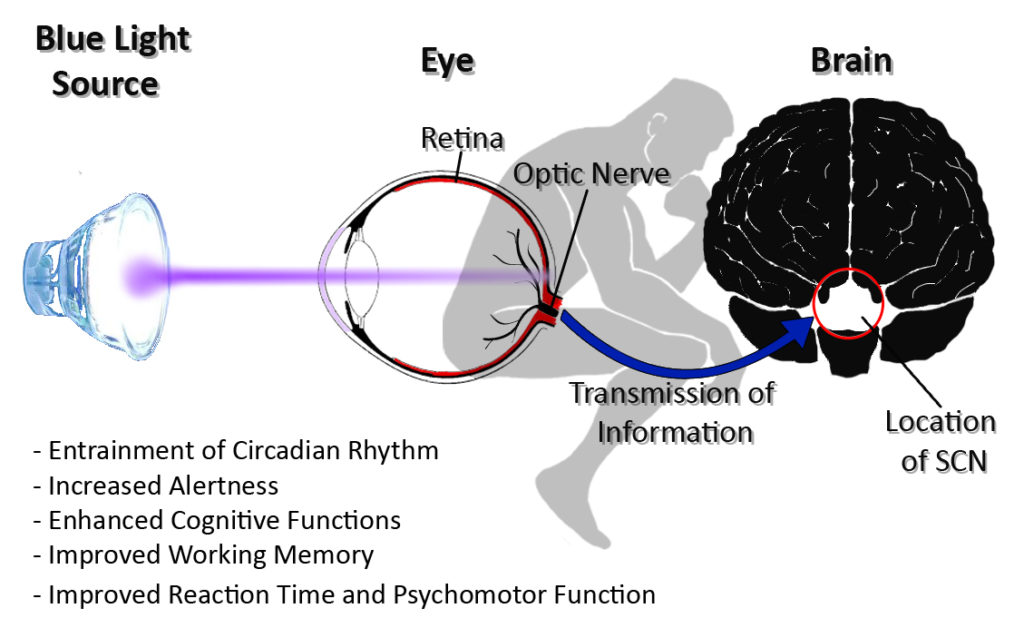
Beneficial Effects of Bright Daylight and Blue Light on Human Performance
26.03.2016 / Scienceandmore / Category: Human Biology
In mammals, the circadian rhythm is a central intrinsic mechanism to measure time and to regulate a wide range of processes that adjust the body to the time of day. The circadian rhythm is essentially modulated by light exposure and darkness, which are environmental cues called “zeitgeber”. In humans, blue light, including the blue light proportion of day light, is perceived by specific cells that contain the photoreceptor melanopsin and are called intrinsically-photosensitive retinal ganglion cells (ipRGCs). These cells are mainly responsible for the activation of the suprachiasmatic nucleus (SCN) in the brain. This area of the brain is also known as the master clock, and regulates the human circadian rhythm (Circadian Clock, Sleep and the Regulation of the Body).
The onset of bright daylight in the morning and darkness in the evening/night play important roles in adjusting the circadian rhythm to 24 hours. The human circadian rhythm would run on a 24 hour plus 15 to 30 minutes cycle without perception of “Zeitgeber” input. Consequently, without this light-mediated adjustment called entrainment, the circadian rhythm would desynchronise and eventually be delayed by around 2.5 to 5 hours after 10 days.
Besides a central function in entrainment, blue light and bright white light were shown to reduce sleepiness and fatigue, and increased alertness and cognitive functions. Significantly, these effects have been shown regardless of time of day. Exposure to blue light and bright white light resulted in alertness during both, day and night! During the night, these effects of reduced sleepiness and increased alertness seem to depend on the blue light-mediated suppression of melatonin. Studies showed reduced night-time melatonin levels in mice that were exposed to blue light for one hour during the early part of the night, in relation to mice that were kept in darkness or were exposed to red light. Conversely, blue light-mediated increase of alertness during the day, in large, seems to be independent of melatonin. Investigations suggested that melanopsin-mediated signals indirectly influence the release of norepinephrine, which is also called noradrenaline, in the brain, and that the effect of increased alertness is based on norepinephrine action.
Investigations on the effects of blue and bright white light exposure of humans suggested an improvement of several functions, such as mood, reaction time, visual search, digit recall, logical reasoning and simple mathematical tasks (addition-subtraction).
Improved Cognitive Performance
Cognition could be defined as the mental process of acquiring knowledge, and cognitive performance as the ability to utilise this knowledge.
When office workers were exposed to blue-enriched white light, they reported subjectively improved alertness, concentration and performance, as well as reduced sleepiness, during this time. Likewise, students (between 16 and 22 years of age) that were exposed to blue-enriched white light for 45 minutes during the first school lesson of the day showed improved concentration in a test that was taken immediately after light exposure, relative to students that were exposed to standard light conditions. The study was conducted during the winter months when the absence of short wavelength light in the morning probably causes a delay of the circadian rhythm. The researchers proposed that the blue-enriched white light would improve concentration by adjusting the student’s circadian clocks to “start of the day”.
Most studies that investigated the beneficial effect of blue or bright white light are of rather short duration. There are, however, longer lasting studies. One study investigated the effect of different light conditions on the academic progress of elementary school students. When students were taught in classrooms with a high degree of daylight for one year, their test scores in a mathematics and reading test were 20 % and 26 % better, respectively, compared to students who were taught in classrooms with little or no daylight. Another study also found that when students were exposed to natural light during the day, scores in mathematics test improved by up to 20 %.
Peak cognitive performance in mammals is dependent on a stable circadian rhythm. A misalignment of the times of sleep and wakefulness with the internal time has been suggested to lead to an impairment of cognitive functions. When mice were continuously exposed to irregular light schedules, with 3.5 hours of white light followed by 3.5 hour of darkness, they showed impaired learning and depression-like behaviour. Interestingly, mice with a genetic defect that results in degenerated melanopsin-containing ipRGCs exhibited normal learning and behaviour/mood. Since these mice were able to perceive light for image formation, the researchers suggested a direct effect of non-image forming blue light, perceived by melanopsin-containing ipRGCs, on cognitive functions.
Additionally, further investigations suggested that a sufficient duration of light exposure is needed to prompt improved cognitive performance. Shorter light exposure of less than one minute and even 18 minutes during the day led to an activation of brain areas that are associated with working memory. However, cognitive performance of the participants was not impacted. This suggested, in accordance with other studies, that a longer exposure of around one hour or more during the day is necessary to prompt improved cognitive performance.
Improved Working Memory
Working memory, sometimes called short term memory, could be defined as a capacity to temporarily hold information; and that is important for decision-making and reasoning.
When study participants were exposed to blue light for 30 minutes during a memory test (in the afternoon), brain areas that are associated to memory maintenance and/or attention to auditory stimuli showed increased activity (determined by functional Magnetic Resonance Imaging (fMRI)). However, no significant difference in performance in a memory test was observed. This was confirmed by other fMRI-based studies. Here, white light exposure for 21 minutes or blue light exposure for 18 minutes increase the activity of brain areas associated with working memory. Eventually, a study found accelerated decision-making processes in participants that resulted in more correct responses in time when blue light was perceived. This accelerated decision-making processes was elicited by short bursts of blue light for less than one minute, as well as for extended exposure of 30 minutes or more. The retention of the faster decision-making effects was found to depend on the time of blue light exposure. The longer blue light was perceived, the longer the effect lasted after cessation of blue light exposure. The researchers speculated that this effect was caused by norepinephrine release in the brain.
Blue Light Exposure shows similar Results as Caffeine
Caffeine has several effects on the body, including increased alertness, and enhanced cognitive functions and reaction times. However, higher doses of caffeine could cause tension, nervousness, anxiety, delay of sleep onset and reduced sleep quality.
Exposing participants of a study to blue light for one hour (at 6 pm) led to a reported increased feeling of arousal similar to the one experienced after ingestion of 240 mg caffeine. Blue light exposure also seemed to improve mood, whereas caffeine did not. Significantly, in combination, caffeine and blue light exposure enhanced mood and arousal to a higher degree than blue light or caffeine alone, and gave the participants an overall feeling of pleasant activation.
Blue light exposure for one hour was also found to improve visual reaction time and psychomotor function. Psychomotor function is the ability to process stimuli from the outside that are linked to a muscular sensation. This includes hand-eye coordination skills such as writing and throwing an object. Caffeine is commonly used to improve psychomotor function, as well as athletic skills. Blue light exposure, however, improved visual reaction time and psychomotor function more consistently compared to the administration of caffeine. Consequently, it was hypothesised that blue light exposure could be beneficial for athletic performance, especially as a lot of sports are played indoors or at night with artificial lights.
Conclusion
Studies that investigated the stimulated brain areas during exposure to blue light found that generally longer durations of light exposure and/or higher light intensities lead to stronger and longer lasting responses. However, the stimulation of some brain areas only lasted for the duration of the light exposure, while in others the stimulation outlasted the light exposure.
Overall, the effects of bright white and blue light exposure seem to be rather subtle and do not lead to huge changes in state and performance as some medication does. However, the effects seem to have a stronger impact in the long-run. Exposure to blue or bright white light for approximately one hour in the morning or before difficult cognitive tasks could be beneficial and increase the speed of information processing, as well as concentration.

References
Alkozei, A., Smith, R. Pisner, D.A., Vanuk, J.R., Berryhill, S.M, Fridman, A., Shane, B.R., Knight, S.A., Killgore, W.D.S. (2016) Exposure to Blue Light Increases Subsequent Functional Activation of the Prefrontal Cortex During Performance of a Working Memory Task. SLEEP, 39(9), 1671-1680.
Ekström, J.G. and Beaven, C.M. (2014) Effects of blue light and caffeine on mood. Psychopharmacology, 231, 3677-3683.
Figueiro, M.G. and Rea, M.S. (2010) The Effects of Red and Blue Lights on Circadian Variations in Cortisol, Alpha Amylase, and Melatonin. International Journal of Endocrinology, 2010(2),829351.
Heschong, L. Wright, R.L. and Okura, S. (2002) Daylighting Impacts on Human Performance in School. Journal of the Illuminating Engineering Society, 31(2), 101-114.
Keis, O., Helbig, H., Streb, J., Hille, K. (2014) Influence of blue-enriched classroom lighting on students’ cognitive performance. Trends in Neuroscience and Education, 4(3-4), 86-92.
LeGates, T., Altimus, C., Wang, H., Lee, H.-K., Yang, S., Zhao, H., Kirkwood, A., Weber, T., and Hattar, S. (2012) Aberrant light directly impairs mood and learning through melanopsin-expressing neurons. Nature, 491(7425),594-598.
Okamoto, Y., Nakagawa, S. (2016) Effects of light wavelength on MEG ERD/ERS during a working memory task. International Journal of Psychophysiology, 104, 10-16.
Shishegar, N., Boubekri, M. (2016) Natural Light and Productivity: Analyzing the Impacts of Daylighting on Students’ and Workers’ Health and Alertness. International Journal of Advances in Chemical Engineering & Biological Sciences (IJACEBS), 3(1), 72-77.
Vandewalle, G., Gais, S., Schabus, M., Balteau, E., Carrier, J., Darsaud, A., Sterpenich, V., Albouy, G., Dijk, D.J. and Maquet , P. (2007) Wavelength-Dependent Modulation of Brain Responses to a Working Memory Task by Daytime Light Exposure. Cerebral Cortex, 17, 2788-2795.
Vandewalle, G., Maquet, P. and Dijk, D.-J. (2009) Light as a modulator of cognitive brain Function. Trends in Cognitive Sciences, 13(10), 429-438.
